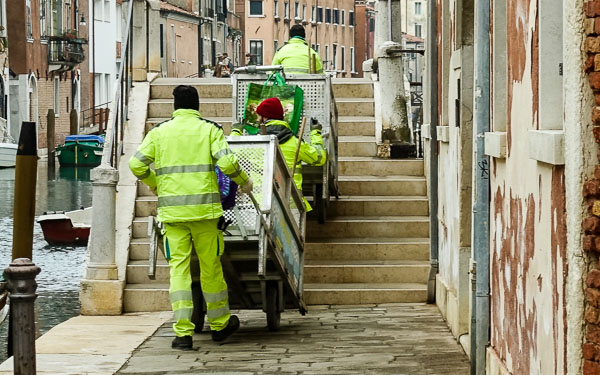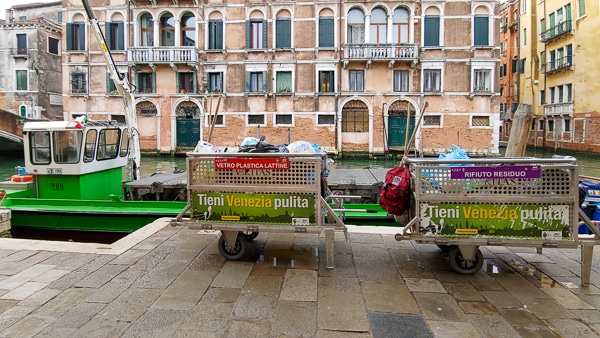|
Venice >
Special topics > Garbage and recycling
Garbage and Recycling Collection in Venice
If you're staying in a vacation apartment, you'll need to
follow the city's rules for recyclables and trash (unless you're willing to
risk a fine).

ABOVE: Spazzini, or sanitation workers,
bounce their collection carts over a bridge in Venice's Cannaregio district.
By
Durant Imboden
When you rent self-catering
accommodation (a.k.a. a vacation apartment), garbage and recycling probably
aren't at the top of your "things I need to know" list. But in Venice, not
knowing the rules about refuse disposal can lead to an expensive fine for your
landlord--a fine that almost certainly will be passed along to you.
Venice's current disposal procedures work like this:
Garbage ("rifiuto residuo")
In the past, you simply left plastic bags of trash outside your door or hanging
from a hook on the front of the building. That's no longer the case. Now you
have two choices:
-
Take your garbage to a designated collection point from 6:30
to 8:30 a.m., Monday through Saturday, and drop it in the bin labeled "Rifiuto
Residuo." (These collection points are scattered around the city, and they're always
next to canals, since the bins are lifted by crane and emptied into garbage
and recycling barges.)
-
Wait for a spazzino, or sanitation worker, to ring
your doorbell--usually between 8:30 a.m. and noon Monday through Saturday,
although hours can vary by neighborhood.
(Your landlord should be able to give you a rough idea of when the trash
collectors arrive at your building.) When the doorbell rings, open the door
or run downstairs and hand your garbage and recycling bags to the spazzino.
Recycling
Recyclables fall into two categories:
Paper, cardboard, and Tetrapak
(carta, cartone, e Tetrapak). These are collected on Monday, Wednesday,
and Friday, during the same hours and in the same way as ordinary garbage. Glass, plastic, cans, and metals
(vetro, plastica, lattine, e metalli). These are collected on Tuesday,
Thursday, and Saturday, during the same hours and in the same way as
ordinary garbage.

ABOVE: If you don't want to wait for the
spazzino to ring your doorbell, you can deposit recycling and rifiuto
residuo in carts by the nearest trash boat between designated hours.
More things to know:
-
The procedures above apply to central Venice and Giudecca. The rules on Murano,
Burano, the Lido di Venezia, and the mainland districts of Mestre and Murano are
slightly different. If you're staying in one of the latter locations, ask your
landlord or landlady for advice.
-
Package your garbage and recycling neatly. Use paper
bags--not plastic bags--for paper. Also pay attention to the rules on what
can or can't be recycled. See below for links to official documents, or get
instructions from your host.
-
When dumping garbage or recycling at collection points, pay attention to the
signs on the bins ("rifiuto residuo" for garbage or a different sign for
recyclables).
-
Do not dump household trash or recycling in public waste receptacles (which are
now in short supply, in part because too many Venetians were using them as
household trash bins).
-
You can get more information about garbage collection and
recycling in a
variety of languages, including
English (PDF download).
-
Important: Violation
of the garbage and recycling rules can lead to a minimum fine of €167
if you get caught, so it's wise to pay attention.
About the author:
 Durant Imboden has
written about Venice, Italy since 1996.
He covered Venice and European travel at About.com for 4-1/2 years before launching
Europe for Visitors (including
Venice for Visitors) with Cheryl
Imboden in 2001. Durant Imboden has
written about Venice, Italy since 1996.
He covered Venice and European travel at About.com for 4-1/2 years before launching
Europe for Visitors (including
Venice for Visitors) with Cheryl
Imboden in 2001.
PC Magazine has called this "the premier visitors'
site for Venice, Italy." Over the years, it has helped more than 30 million
travelers. For more information, see About our site,
our Europe for Visitors
press clippings,
and
our reader testimonials.
| |
|